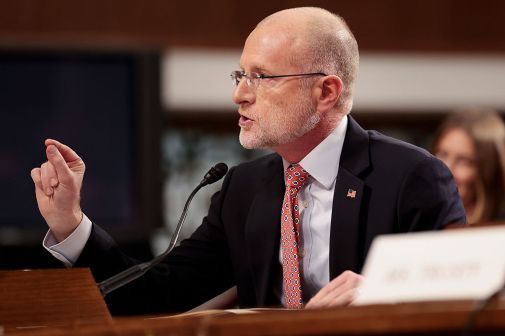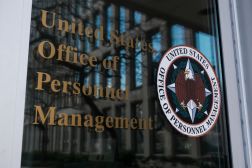Trump AI plan and orders aim to deregulate, police bias and compete globally

President Donald Trump released his much-anticipated AI Action Plan and signed three corresponding executive orders Wednesday, centering efforts on competition with foreign adversaries like China and outlining dozens of actions for the federal government.
The 28-page plan is divided into three pillars — accelerating innovation, building infrastructure, and leading in international AI diplomacy and security — and generally prioritizes eliminating barriers for the technology, promoting widespread use of American AI, and eradicating what the administration defines as “bias” from those tools. Meanwhile, the orders signed by Trump later Wednesday set into motion several of those actions related to government procurement of ideologically “neutral” AI, data center infrastructure, and promotion of U.S. technology.
“We’re not alone in recognizing the economic, geopolitical, and national security importance of AI, which is why winning the AI race is non-negotiable,” Michael Kratsios, director of the White House Office of Science and Technology Policy, said during a call Wednesday morning with reporters.
Kratsios said the plan contains over 90 actions and was developed with “overwhelming input from industry, academia and civil society,” including a request for information that generated over 10,000 responses. The plan, he said, was also developed with urgency in mind as all of the actions can be accomplished in six months to a year.
Recommended tasks in the plan include updating federal procurement guidance to ensure agencies purchase the technology from only companies “who ensure that their systems are objective and free from top-down ideological bias,” removing federal regulatory burdens for AI, and limiting federal funding to states with “burdensome AI regulations.” It also broadly advises civilian agencies and the Department of Defense to accelerate adoption of the technology.
“For too long, much of our tech industry pursued a radical globalism that left millions of Americans feeling distrustful and betrayed,” Trump said during his keynote address at an AI event in Washington on Wednesday evening.
That summit, titled “Winning the AI Race,” was hosted by Hill and Valley Forum, an organization established by venture capitalists and lawmakers to counter Chinese tech, and the “All-In” podcast, whose co-hosts include White House AI czar David Sacks.
“Many of our largest tech companies have reaped the blessings of American freedom, while building their factories in China, hiring workers in India, and stashing profits in Ireland, you know that, all the while dismissing and even censoring their fellow citizens right here at home,” Trump said. “Under President Trump, those days are over.”
The action plan document and orders come after Trump rescinded President Joe Biden AI executive order and directed the creation of his own AI Action Plan in the first days of the administration. While the Biden administration’s efforts had focused on balancing AI safety with speed, the Republican party platform in 2024 called the approach “dangerous,” arguing it hindered innovation and imposed “radical leftwing ideas on the” technology’s development.
‘Ideological bias,’ deregulation
Following in that path, one theme of the new plan and directives is policing what the administration defines as bias in the systems.
One of the executive orders, titled “Preventing Woke AI in the Federal Government,” establishes the administration’s definition for “unbiased AI” and directs the Office of Management and Budget to issue agency guidance on assessing AI that fits that criteria as well as to adopt procedures to ensure that models used by the government are compliant.
The action plan also directs the Department of Commerce and the National Institute of Standards and Technology to revise the AI Risk Management Framework to get rid of “references to misinformation, Diversity, Equity, and Inclusion, and climate change.”
A senior administration official on Wednesday pointed to DEI as the “main” target of the efforts for federal agencies to contract only with developers who are free from ideological bent.
That official continued that the White House expects the General Services Administration to develop contract language that requires large language models bought by the federal government to “abide by a standard of truthfulness — of seeking accuracy and truthfulness — and not sacrificing those things due to ideological bias.”
Simultaneously, an emphasis on deregulation was also a trend in the plan. The framework recommended that OSTP issue a request for information from businesses and the public about regulations “that hinder AI innovation and adoption,” as well as work by agencies to identify and repeal or revise burdensome rules, memos, orders, guidance and other policies.
“Instead of cultivating skepticism, our policy is to encourage and enable AI adoption across government and the private sector through regulatory sandboxes and sector-specific partnerships,” Kratsios said.
State regulations are also a target. As part of that work, the OMB is advised to work with agencies that oversee AI-related programs with discretionary spending to make sure they “consider a state’s AI regulatory climate when making funding decisions and limit funding if the state’s AI regulatory regimes may hinder the effectiveness of that funding or award.” The document similarly recommends that the Federal Communications Commission evaluate state AI regulations that interfere with the Communications Act of 1934.
Those actions directed at states come after the Senate this month voted 99-1 to strike down a controversial proposal to include a 10-year ban on state and local AI regulation in Trump’s tax bill.
Reactions mixed
The action plan was immediately met with both praise and critiques Wednesday. Industry largely praised the effort, while civil society organizations called out the administration’s efforts to penalize state AI regulations and police what it defines as bias.
Jason Oxman, president and CEO of the Information Technology Industry Council, applauded the plan as “a blueprint to usher in a new era of U.S. AI dominance.”
“The administration’s vision takes essential steps to ensure the U.S. can win the global AI race by prioritizing U.S. energy production and infrastructure development to power AI’s growth, promoting U.S. AI leadership internationally by supporting the export of the full stack of American AI technologies to partners and allies, and accelerating adoption of AI across the public and private sectors,” Oxman said in an emailed statement.
Oxman said the plan addresses priorities for the industry, such as addressing challenges with data center and power infrastructure permitting and promoting AI use across the government. ITI’s member companies include OpenAI, NVIDIA, Google, Anthropic, Meta and Microsoft.
Samir Jain, vice president of the nonprofit Center for Democracy Technology, which focuses on digital civil liberty and human rights, said in an emailed statement that the plan amounted to a “missed opportunity.”
“Although promoting innovation is important, the Plan whiffs by failing to include measures to help ensure that AI development and deployment happens responsibly and addresses potential harms,” Jain said. “Instead, the Plan includes actively detrimental provisions.”
Jain pointed to the state-focused and bias elimination actions as examples, saying the “government should not be acting as a Ministry of AI Truth or insisting that AI models hew to its preferred interpretation of reality.” He did, however, note several positives to the plan, including its promotion of open-source and open-weight systems and building out the ecosystem for AI evaluation.
Continuations, government use
While some elements of the plan deviate from the previous administration’s work, there is continuity in certain areas.
The plan, for example, includes a recommendation to make use of federal lands for constructing data centers and power infrastructure, which is something the Biden administration also released an executive order to address. It also continues the pilot for the National AI Research Resource, or NAIRR, at the National Science Foundation, which is a bipartisan effort started under the last administration to make AI research infrastructure broadly accessible.
Under the plan, it’s recommended that the existing Chief Artificial Intelligence Officer Council is formalized as the “primary venue for interagency coordination and collaboration on AI adoption,” and that the body collaborates with other executive councils, including the Chief Data Officer Council and Chief Information Officer Council.
Within the federal government, the plan also emphasizes a desire for widespread adoption of AI, offering recommendations on the creation of a talent-exchange program to designate federal employees to rotate to other agencies that need AI expertise and for widespread agency access to LLMs. Specifically, it recommends that all federal agencies are mandated to “ensure — to the maximum extent practicable — that all employees whose work could benefit from access to frontier language models have access to, and appropriate training for, such tools.”
As part of those efforts, the plan advises GSA to launch “an AI procurement toolbox” that establishes a uniform approach across the federal government. “This system would allow any Federal agency to easily choose among multiple models in a manner compliant with relevant privacy, data governance, and transparency laws,” the plan said. GSA is also recommended to create an “Advanced Technology Transfer and Capability Sharing Program” to transfer AI tools and uses among agencies.
GSA has already deployed its own internal AI platform called GSAi that allows users to access a variety of models, and FedScoop previously reported that the agency is looking into potentially integrating that tool with technology at other agencies as well.
This story was updated on July 23 to reflect additional information throughout, including more detail about the executive orders and the signing event, as well as comments from the president.






